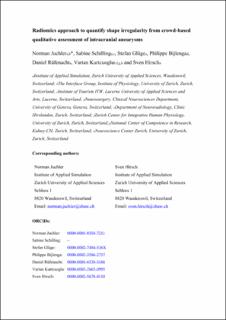Please use this identifier to cite or link to this item:
https://doi.org/10.21256/zhaw-19849Full metadata record
| DC Field | Value | Language |
|---|---|---|
| dc.contributor.author | Juchler, Norman | - |
| dc.contributor.author | Schilling, Sabine | - |
| dc.contributor.author | Glüge, Stefan | - |
| dc.contributor.author | Bijlenga, Philippe | - |
| dc.contributor.author | Rüfenacht, Daniel | - |
| dc.contributor.author | Kurtcuoglu, Vartan | - |
| dc.contributor.author | Hirsch, Sven | - |
| dc.date.accessioned | 2020-03-19T15:55:24Z | - |
| dc.date.available | 2020-03-19T15:55:24Z | - |
| dc.date.issued | 2020-03-17 | - |
| dc.identifier.issn | 2168-1163 | de_CH |
| dc.identifier.issn | 2168-1171 | de_CH |
| dc.identifier.uri | https://digitalcollection.zhaw.ch/handle/11475/19849 | - |
| dc.description | This is an Accepted Manuscript of an article published by Taylor & Francis in Computer Methods in Biomechanics and Biomedical Engineering : Imaging & Visualization on 17.03.2020, available online: https://www.tandfonline.com/doi/full/10.1080/21681163.2020.1728579 | de_CH |
| dc.description.abstract | The morphological assessment of anatomical structures is clinically relevant, but often falls short of quantitative or standardised criteria. Whilst human observers are able to assess morphological characteristics qualitatively, the development of robust shape features remains challenging. In this study, we employ psychometric and radiomic methods to develop quantitative models of the perceived irregularity of intracranial aneurysms (IAs). First, we collect morphological characteristics (e.g. irregularity, asymmetry) in imaging-derived data and aggregated the data using rank-based analysis. Second, we compute regression models relating quantitative shape features to the aggregated qualitative ratings (ordinal or binary). We apply our method for quantifying perceived shape irregularity to a dataset of 134 IAs using a pool of 179 different shape indices. Ratings given by 39 participants show good agreement with the aggregated ratings (Spearman rank correlation ρSp=0.84). The best-performing regression model based on quantitative shape features predicts the perceived irregularity with R2:0.84±0.05. | de_CH |
| dc.language.iso | en | de_CH |
| dc.publisher | Taylor & Francis | de_CH |
| dc.relation.ispartof | Computer Methods in Biomechanics and Biomedical Engineering : Imaging & Visualization | de_CH |
| dc.rights | Licence according to publishing contract | de_CH |
| dc.subject | Intracranial aneurysm | de_CH |
| dc.subject | Morphology | de_CH |
| dc.subject | Radiomics | de_CH |
| dc.subject | Multi-rater assessment | de_CH |
| dc.subject.ddc | 616.8: Neurologie und Krankheiten des Nervensystems | de_CH |
| dc.title | Radiomics approach to quantify shape irregularity from crowd-based qualitative assessment of intracranial aneurysms | de_CH |
| dc.type | Beitrag in wissenschaftlicher Zeitschrift | de_CH |
| dcterms.type | Text | de_CH |
| zhaw.departement | Life Sciences und Facility Management | de_CH |
| zhaw.organisationalunit | Institut für Computational Life Sciences (ICLS) | de_CH |
| dc.identifier.doi | 10.1080/21681163.2020.1728579 | de_CH |
| dc.identifier.doi | 10.21256/zhaw-19849 | - |
| zhaw.funding.eu | No | de_CH |
| zhaw.issue | 5 | de_CH |
| zhaw.originated.zhaw | Yes | de_CH |
| zhaw.pages.end | 546 | de_CH |
| zhaw.pages.start | 538 | de_CH |
| zhaw.publication.status | acceptedVersion | de_CH |
| zhaw.volume | 8 | de_CH |
| zhaw.embargo.end | 2021-03-18 | de_CH |
| zhaw.publication.review | Peer review (Publikation) | de_CH |
| zhaw.webfeed | Biomedical Simulation | de_CH |
| zhaw.webfeed | Predictive Analytics | de_CH |
| zhaw.webfeed | Medical Image Analysis and Data Modeling | de_CH |
| zhaw.funding.zhaw | AneuX | de_CH |
| zhaw.author.additional | No | de_CH |
| Appears in collections: | Publikationen Life Sciences und Facility Management | |
Files in This Item:
| File | Description | Size | Format | |
|---|---|---|---|---|
| 2020_Juchler_etal_Radiomics_Computer-Methods-in-Biomechanics.pdf | Accepted Version | 1.38 MB | Adobe PDF |  View/Open |
Show simple item record
Juchler, N., Schilling, S., Glüge, S., Bijlenga, P., Rüfenacht, D., Kurtcuoglu, V., & Hirsch, S. (2020). Radiomics approach to quantify shape irregularity from crowd-based qualitative assessment of intracranial aneurysms. Computer Methods in Biomechanics and Biomedical Engineering : Imaging & Visualization, 8(5), 538–546. https://doi.org/10.1080/21681163.2020.1728579
Juchler, N. et al. (2020) ‘Radiomics approach to quantify shape irregularity from crowd-based qualitative assessment of intracranial aneurysms’, Computer Methods in Biomechanics and Biomedical Engineering : Imaging & Visualization, 8(5), pp. 538–546. Available at: https://doi.org/10.1080/21681163.2020.1728579.
N. Juchler et al., “Radiomics approach to quantify shape irregularity from crowd-based qualitative assessment of intracranial aneurysms,” Computer Methods in Biomechanics and Biomedical Engineering : Imaging & Visualization, vol. 8, no. 5, pp. 538–546, Mar. 2020, doi: 10.1080/21681163.2020.1728579.
JUCHLER, Norman, Sabine SCHILLING, Stefan GLÜGE, Philippe BIJLENGA, Daniel RÜFENACHT, Vartan KURTCUOGLU und Sven HIRSCH, 2020. Radiomics approach to quantify shape irregularity from crowd-based qualitative assessment of intracranial aneurysms. Computer Methods in Biomechanics and Biomedical Engineering : Imaging & Visualization. 17 März 2020. Bd. 8, Nr. 5, S. 538–546. DOI 10.1080/21681163.2020.1728579
Juchler, Norman, Sabine Schilling, Stefan Glüge, Philippe Bijlenga, Daniel Rüfenacht, Vartan Kurtcuoglu, and Sven Hirsch. 2020. “Radiomics Approach to Quantify Shape Irregularity from Crowd-Based Qualitative Assessment of Intracranial Aneurysms.” Computer Methods in Biomechanics and Biomedical Engineering : Imaging & Visualization 8 (5): 538–46. https://doi.org/10.1080/21681163.2020.1728579.
Juchler, Norman, et al. “Radiomics Approach to Quantify Shape Irregularity from Crowd-Based Qualitative Assessment of Intracranial Aneurysms.” Computer Methods in Biomechanics and Biomedical Engineering : Imaging & Visualization, vol. 8, no. 5, Mar. 2020, pp. 538–46, https://doi.org/10.1080/21681163.2020.1728579.
Items in DSpace are protected by copyright, with all rights reserved, unless otherwise indicated.